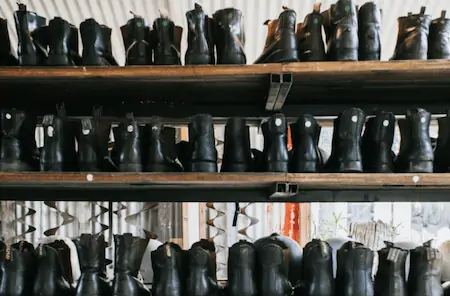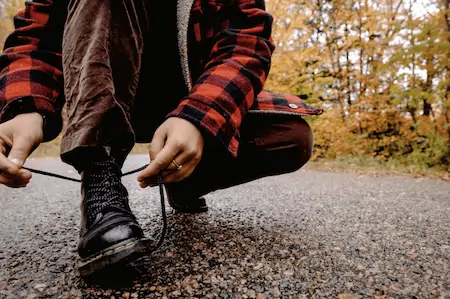Waking around in new shoes that you love is one of those special feelings in life. However, trying on a new shoe comes with the risk of heel slippage. If you have ever worn a pair of shoes, you already know how annoying heel slippage can be.
In this article, we will discuss how to fix heel slippage in boots so you can hike around in those fantastic boots you’ve just bought without any worries.
What Is Heel Slippage?
Heel slippage is the incident when your heel shoe slips away from the soles of your shoe, causing your foot to slip partially or entirely out of your shoe and possibly causing a sprain or some form of pain or injury.
It is not an uncommon phenomenon. In fact, a majority of new shoe owners experience this. As the brand new shoes are a bit stiff and don’t bend and move as flexibly as your foot, it causes the boot’s structure to slip away when you step on uneven terrain or land your feet awkwardly.
As you wear the boots more and more, they become more flexible, and heel slippage occurs much less frequently. Ideally, the slippage should not happen after a few days of use.
Causes Of Heel Slippage
Heel slippage can occur for many reasons, and you should be aware of them so that you know how exactly to fix the problem when it happens. Here are some of the leading causes of heel slippage.
#1. Size of the Boots
The size of the boots is the main factor that causes most of the heel slippage that people experience. If your shoe is not a good fit for your feet, your chances of experiencing heel slippage rise drastically.
If your boots are too big, your feet will move around in them without any support, causing you to step improperly and your boot to slip off.
In contrast, if they are smaller, you will have a lesser surface to put weight on, and that might cause slippage. So, when buying your boots, make sure they are a good fit in both length and width.
#2. Boots Are Improperly Laced
If the boots are laced up firmly but not excessively tightly, it will lower the chances of slippage. But, tying the laces improperly will increase the likelihood.
#3. Improper Gait
That’s right! Walking awkwardly while wearing boots can cause heel slippage, especially if the terrain you are walking on is uneven and ragged.
For example, if you land on a small raised patch on the ground with the middle of your feet, you will experience pain and heel slippage.
#4. New Boots Are Rigid
New boots don’t respond well to the fluid and varying pattern of your feet’ movement while walking because they tend to be a bit inelastic while they are new. This can cause heel slippage.
#5. Worn Insoles
Old boots can cause slippage too. If the boots’ insoles are damaged or worn out, it will cause a loose fit and increase the likelihood of slipping.
#6. Perspiration
Your feet sweating inside your boots can cause dampness inside, decreasing the friction between your shoes and your socks.
How To Fix Heel Slippage?
Now that you know how slippage occurs let’s talk about the ways to fix your heel slippage problem.
#1. Buy the Right Sized Boots
It is always a good idea to buy an essential item like your boots in person, as your comfort level will be dependent on how good of a fit it is. And boots of the exact sizes might fit you differently because of subtle variances.
So, make sure that the pair you are buying fits comfortably and firmly. They must match the length and width of your feet.
#2. Learn Lacing Methods
There are many methods and aids for lacing that are meant to help you lace your boots properly. A popular method to use for tying your laces well is the ‘rabbit hole’ method. In addition, the ‘hiking boot’ method is a prevalent one among hiking enthusiasts.
If you want to get some extra help tightening up your laces, you can get lace anchors, which will stop your laces from getting loose from your regular activities. You can also use the top-most holes in your boots and heel lock lace your shoes to avoid heel slippage.
#3. Adding A Tongue Pad
A tongue pad is an accessory that is stuck to the bottom side of the tongue of your boots. The pads help to make your feet fit more snugly into the shoes.
Furthermore, they slightly nudge your heels to move backward and get aligned with the heel counter of the shoe, lowering the chance of heel slippage.
#4. Replacing The Insoles On Old Boots
Sometimes old boots feel so loose that you might think they will never be useful again. However, you will be surprised how easily an old pair of boots can be firmed up.
Just by replacing the insoles, you will feel a significant difference in fit. This can be an excellent option for you if you don’t want to buy a new pair of boots.
#5. Break In The Boots
When the boots are new and stiff, it’s easy for them to slip out. So, before going out on a hiking trip or some long adventure in your new boots, you need to break them in.
Breaking in new boots simply means using them for a while so that they can stretch according to the dimensions of your feet and lose their stiffness so that they become comfortable to wear.
So, walk around while wearing the boots for a while, and do your regular household chores to stress them.
#6. Using A Heel Grip
A heel grip is an accessory that supports your heel placement when your boots are a bit too long for you. The heel grip fills out the extra space that would remain behind your heels inside the shoes.
This ensures a better fit and lowers heel slippage likelihood.
#7. Use Special Socks
There are many types of socks available in the market that you can use to alleviate your heel slippage problems. A lot of the issues discussed before can be solved by using specific kinds of socks. Here are some examples.
- If your feet are sweaty, you can get thicker and more absorbent socks to reduce the dampness inside your shoes
- There are slip-resistant socks that have higher friction against the interior material of your boots, causing your feet to stay firmly in place
- If your boots are slightly loose, you can wear a thicker sock to make the shoes a better fit
#8. Use Hair Spray
Oddly enough, using hair spray on your feet after wearing socks and before putting on the boots can help reduce heel slippage. This is due to hair spray being a sticky substance that will help your feet stay attached to your shoes.
This is a safe use of hair spray, and you don’t need to worry about the removal process because you can wash or wipe it off with a wet towel after you take off your boots.
#9. Set Your Feet Properly Inside Your Boots
Sometimes, people don’t push their heels back to the heel counter of their boots and lace-up like that.
It might seem insignificant, but I assure you that you can reduce your chances of experiencing heel slippage by taking the time to carefully put your heel all the way back into the boots heel counter before lacing.
#10. Fix Your Gait
If you followed most of the tips and are still suffering from frequent heel slippage, chances are it has to do with the way you walk.
Typically, you want to be careful while walking in boots, especially if they are high ones. Also, you need to be extra cautious while passing jagged and rocky areas.
When walking on such terrain, make sure to firmly plant the heel first before putting weight on other parts of your foot.
#11. Boot Maintenance
Everyone knows that keeping your boots in good shape will improve their intended performance. Keep the insides of your boot dry and clean, so it doesn’t slip.
Make sure the lace is not worn out or damaged. Inspect if the bottom of your shoes has been damaged and repair accordingly.
Conclusion
While heel slippage may be a common occurrence, you can prevent it from happening to you by being well-informed and prepared about it from the get-go. And with this discussion, hopefully, you have learned all you need about how to fix heel slippage in boots.
So, take good care of your beloved pair of boots, take any precautions you need, and break in those new boots before you commit to wearing them for a prolonged time.


